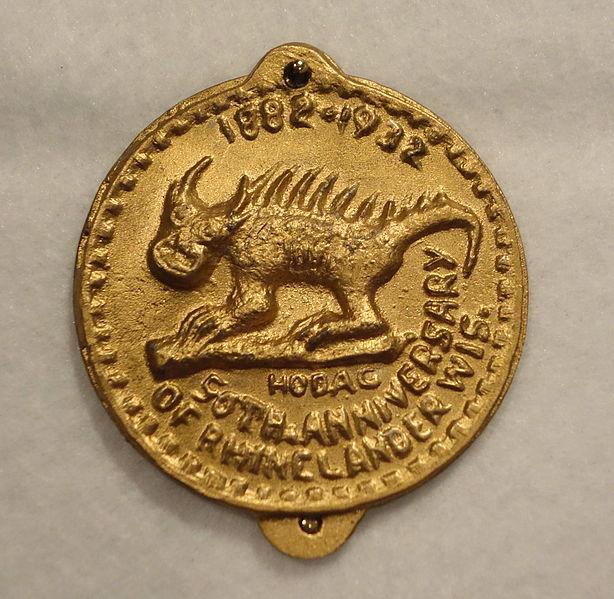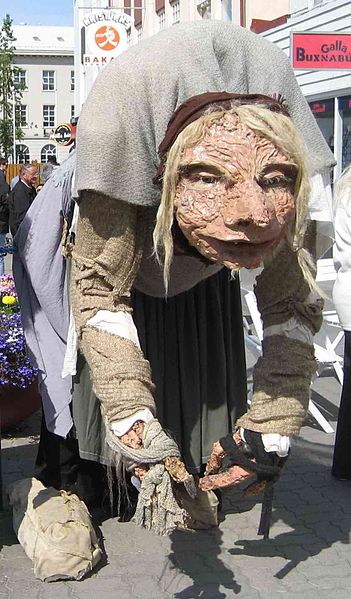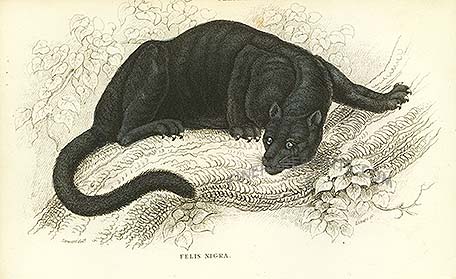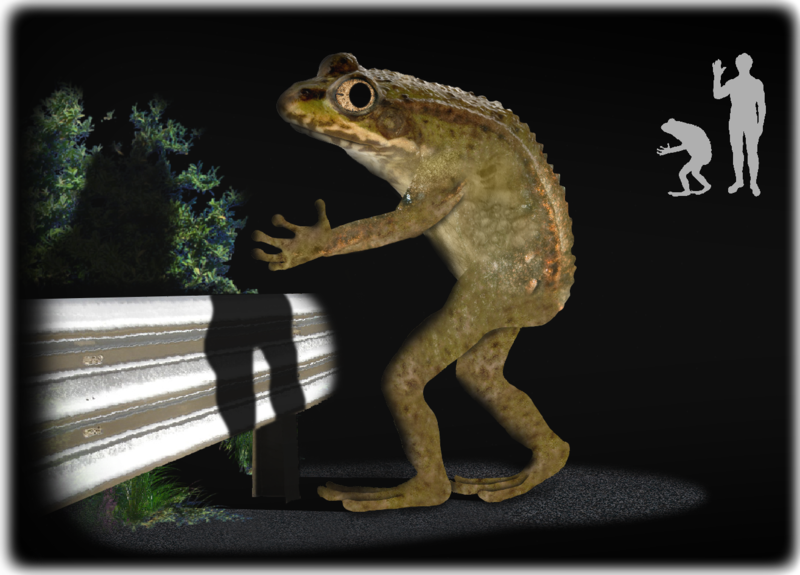Remember those fearsome critters we spoke of in our last article for FolkloreThursday.com? Like we mentioned in the previous writing, there are literally hundreds, if not thousands, of these critters scurrying about in the legends and lore of North America. Here, we catch up with five “lesser known,” but no less fascinating, monsters spread across this vast land.

1. The Hodag
We briefly introduced the Hodag in our previous article, and its fantastical image was used as the header for that piece, so we felt it appropriate to give a nod to the Hodag in this writing. After all, there are few monsters out there which can provide a more frightful and imaginative visage than that of the Hodag hailing from the lumbering frontier community of Rhinelander, Wisconsin.
Consider: a 185-lb lizard-like beast with razor-sharp teeth, horns protruding from its temples on both sides of its disproportionately-sized dog-like head, bulging eyes to scare the devil himself, and spikes like that of a small dragon’s cresting along its back and down its spiny tail. Long claws set off the monster’s thick, short legs. Its meat of choice was human if snapping turtles weren’t available, so it is told.
Seems like a bit of dialogue right out of a scene in a Monty Python film, except this creature terrorized hulking lumberjacks in the frontier lands of the northern United States near the turn of the previous century. Not even the men’s dogs would chase it down or face the thing. It is said that even if their dogs came across the foul beast, that they would be scattered in pieces from the attack.
It was in 1893 that the Rhinelander newspaper picked up the story from lumberman Gene Shepherd, when he reported that he had captured and killed the monster. Riding the wave of popularity, Shepherd declared that he would capture a live Hodag and display it publicly for all to see at the Oneida County Fair.
Display a monster he did, though it was one he fashioned out of cowhide and cattle horns and placed in a display that hundreds lined up to see. When the Smithsonian got wind of the “authentic scientific discovery”, and forthrightly announced a trip to examine it, Shepherd was forced to admit that his catch was a fabrication—a prank of fearsome proportions.
What began as a prank (whose tale has been told in several Paul Bunyan stories and whose miniature was the prized gift of a future U.S. President—then Senator Robert F. Kennedy) could be considered a living legend to this day, as it has sparked its own celebrity through the centuries and maintained a respectable economic boom that tourists still have no trouble paying to see. It is the official symbol of Rhinelander, Wisconsin. It’s also the local high school mascot, and the fearsome beast continues to be inspiration for many businesses and their icons.
Oh, and that famous photograph of the big green, fiberglass monster you’ve seen? Well, that sits outside the main entrance to the Rhinelander Chamber of Commerce. So much for a prank at the county fair. The Hodag commands a ferocious presence (including blowing smoke from its nostrils and with glowing red eyes) that is there for all to see, and traveling from both near and far they surely do come to see.

2. The Wampus Cat
Animal shapeshifters, sometimes called therianthropes, are found the world over, probably best known for the classification of lycanthropes, a.k.a. werewolves. However, one of the most terrifying of these creatures is really a witch known as the Wampus, sometimes referred to as the Gallywampus or the Whistling Wampus.
Note: D.C. McGannon is currently writing a book about the Wampus Cat to be announced for publication in 2018. This was the monster that was described to him as a child that waited in trees to devour him for disobeying his parents or staying out to play too late into the evening. Once he stayed out past dark and remembers a rustling in a willow tree, and was sure it was the Wampus that had come to collect him. As he ran past the tree toward the safety of his home, a couple of bats flew from the tree close to him. Though he loves bats, he is forever convinced it was the Wampus Cat shapeshifting into these flying creatures of the night and flitting away as he was, after all, correcting his bad behavior and returning home. And now you know friend, why it is that D.C. is so disturbed as an adult. Add to the constant presence of the Wampus during his childhood, the regularly told story of the giant looking for his Big Toe told to him by his grandmother, and it’s a wonder he functions with any sense of emotional stability.
One of the most fascinating stories that tell of the origins of the Wampus is from Cherokee legend. It is said that the Wampus Cat was once a beautiful woman who became disgruntled about always being left behind when the men of her village would venture out in their hunting parties. One night she followed her husband and found the men around a campfire sharing sacred stories and doing magic. It was strictly forbidden by their laws for women to hear and see such things, so the medicine man, upon discovering the woman hidden behind a rock, magically bound the woman to the pelt that she covered herself with. It was the pelt of a mountain lion, and to this day she is said to roam the countryside wailing and moaning as a magical cat beast.
Stories have been told throughout the years of those happening upon a wild beast with yellow glowing eyes, angry and hostile as it seeks to return to its human body, forever bound and able to perform sorcerous acts and induce madness in men. Still others tell of the Wampus as a protective spirit. Either way, it is a formidable spirit that is not to be trifled with, especially if you’re a child who has stayed out too late to play against his parents’ instruction.
Today, the Wampus is mostly known as a bogeywoman of sorts, however there are those who hunt and roam the southern forests of the U.S. who tell of a howling animal deep in the trees, and those who have seen this animal speak of a monster that is restless, and prowling, seeking for something that forever evades it.
It’s probably best to come inside when you’re told after all.
Bonus: We have a term here that stems directly from this legend. Cattywampus. If a situation is said to have become “cattywampus,” it means that things have become downright confusing and messy, and it’s best to get out of that situation as quickly as possible to avoid negative consequences.

3. The Giant Basket Ogress
Here, there be giants!
There are tales of giants around the world, and seemingly their “tall tales” are becoming ever popular once more in our time. What many don’t commonly consider as part of the North American fabric of folklore is that our side of the ocean is rife with stories, and the bones and burial mounds it seems, to back up the notion that our lands were at one time running with giants. Storytellers from tribes north to south, east to west speak of giants who inhabited our land before them, and were the cause of great distress among many peoples and nations.
Here is a popular giantess, whose stories may remind you of others from European and Scandinavian lore. We’ll point out a couple after we introduce you to this cannibalistic giant.
The Basket Ogress is known as a “booger lady” or more commonly, the bogey woman. She is a giant cannibal who eats only children, and her stories are told largely in tribes along the Northwest Coast from Washington State (U.S.) to British Columbia (Canada).
She is a fierce creature to be sure, and one who is always munching as she travels, but her preferred delicacy is children and will seek them out day or night to place on her hot stones for a tasty meal.
Often, parents would tell the story of the Basket Ogress for disciplinary and educational ends in mind. “Don’t stray too far,” they would say, “or the Basket Ogress will get you and eat you.” (Good thing we have modern counseling and proper pharmacy these days to deal with the trauma inflicted by such stories.) “Be good,” parents warned, “or the giant Ogress will find you and away with you. You’ll be gone and provide her evening meal!” (Seriously!)
She is a grumpy giant, always hungry, and always looking or listening for children. When she finds them, she will collect them and place them in her larger-than-life basket and carry them home to be boiled or baked into her next meal.
It’s a curious thing, however, that in almost all of the stories, the children escape the Ogress. No wonder she’s always hungry!
If the legend of the Basket Ogress seems familiar, we can point to Grýla, of Scandinavian folklore. The giantess in the (much colder) lands across the sea is known for kidnapping children that stay out past curfew or wander away from their parents, carrying them away in her giant potato sack. She’s the mother of the sometimes dangerous, sometimes comical Yule Lads (think smaller, more mischievous Santa Clauses who take food and cause trouble instead of leaving gifts), and the owner of the Yule Cat, who also happens to be a giant and fond of the taste of children.
Let us also not forget Baba Yaga from Russian lore, one of the most powerful witches in history. Sometimes she is described as a giant, sometimes in the mood to help children solve major life issues, but sometimes in the mood to gobble them up, bones and all.

4. The Beast of Bladenboro
One of the most violent critters on this list, the Beast of Bladenboro remains a true mystery to this day. Witnesses and newspapers would report the death of local dogs in graphic detail. Many of those reports would focus on large pools of blood, maimed bodies, and, specifically, jaws having been removed from the heads of the dogs. Other reports would go on to describe the heads being crushed, and there was a man who investigated a nearby goat attack, noting the similarities, saying that the goat’s head had been nearly flattened.
Those were the attacks, and the left over carnage was evidence. The sightings of the beast responsible were a little harder to pin down. People described it both as a wolf-like creature and a cat-like creature. Others would go so far as to call it a panther or a bear. Locals began thinking of it as a vampiric creature, and it gained some comparisons to the Chupacabra over time, albeit less interested in goats than dogs.
Now, Blandeboro was a small town, but the mayor was pretty smart to play up some of those vampiric reports. He even scheduled a showing of a movie called The Big Cat to play at the local cinema (a theatre which he happened to own). Later, he would describe the Beast of Bladenboro as “10% real, 90% imagination,” saying that the publicity was good for the town. Unlike many outright hoaxes, however, the question remains …
What exactly mangled those dogs (and a goat, and reportedly cows nearby as well) in such a violent and graphic manner?

5. Loveland Frogs
As The Monster Guys, we’ve talked about Sasquatch, Dogman, Lizard People, and we have briefly discussed the differing legends surrounding the Goatman.
The Loveland Frog takes these near-anthropomorphic beings and cranks the dial on the bizarre to the far end of the spectrum. That’s right ladies and gents, we’re talking Frog People.
In 1955, an unknown man came across what he described as three figures grouped together, conversing. These figures were about four feet tall and stood upright, yet they looked like frogs. And, get this, after he was spotted by one of the creatures, it raised what he described as a “wand” and shot sparks at him, scaring the man away. Yeah, if we encountered a giant frogman shooting Stupefy spells at us, we’d be out of there, too.
The story’s veracity is called into question due to minor changes from telling to telling, and the fact that the business man telling the story has never been named. Yet, the plot thickened when two separate police officers in 1972 reported sightings only two weeks apart, both of them describing frog- or lizard-like people on the road. Small details included frog-shaped heads and mouths, wrinkly skin where hair might usually appear, and, in the second sighting, a tail.
In 2001, the second police officer redacted his own report, saying that it was probably just a big pet lizard that had gotten too large for its owner’s aquarium, causing us to scratch our heads even further. That was some pet!
Further, in 2016, two Pokemon Go players spotted a “giant frog” by a body of water standing on two legs. One of the mobile gamers stopped playing to snap a few pictures and video of the creature, although they’ve received a lot of online skepticism (we’re not sure why).
The strangeness continues to this day.
Fearsome critters? Check. Tall tales? Check. Fantastic beasts? Check. We’ve got ‘em all, folks. In our previous article we invited you to pull up a chair and enjoy a few of our stories. That invitation is extended here. From native magic and lore to pranks-turned-legend to creatures lying in wait for the stray disobedient child, North American monsters are sure to invoke the mysterious, and may frighten the faint of heart, but will most certainly, at the very least, entertain.
Resources:
Do watch this video of Vi Hilbert telling her father’s story of the Basket Ogress in her native tongue of Lushootseed (Skagit) while translating it into English while speaking at The Evergreen State College. (Select ‘Basket Ogress’ from the drop down menu to watch it.) http://bela.music.washington.edu/ethno/hilbert/voicesVideo.html
